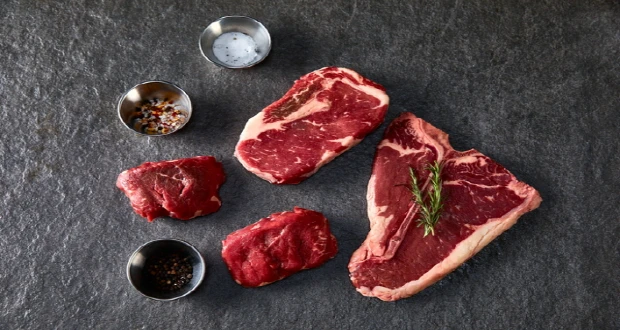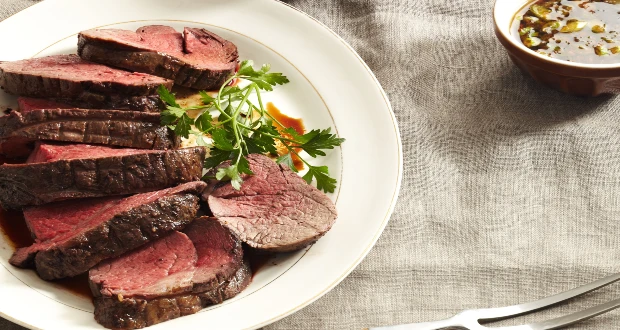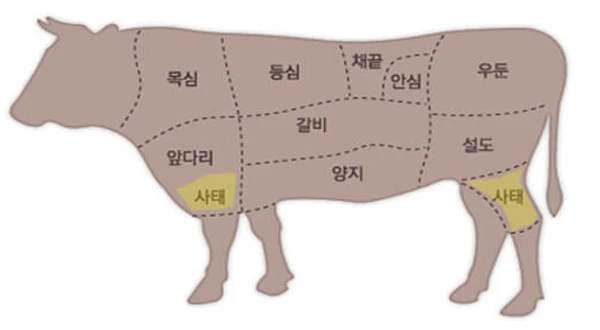Beef benefits, characteristics of each part, calories, storage method
Beef Nutrition

| Beef (100g) Nutrition | |||
| Carbohydrate | Protein | Fat | Calories |
| 0.2g | 26g | 15g | 250kcal |
| Main Nutrition | Protein, B vitamins, selenium | ||
| Main Benefits | Prevents anemia, supplements protein, boosts immunity, prevents heart disease | ||
| Side Effects | Excessive intake worsens hyperlipidemia and increases the risk of heart disease. | ||
Beef refers to the meat of slaughtered cows. Beef and Korean beef sold domestically tend to be slightly more expensive than pork and chicken. It is a type of meat that is popular around the world because it is juicy and has different flavors and tastes for each part. It is rich in animal protein and contains various vitamins, so it has good nutritional value. It can be eaten grilled, added to soup or steamed food, and since it has little risk of parasites, it can also be eaten raw like fish.
Beef benefits

1. Anemia prevention
Anemia is a disease that occurs when there is iron deficiency in the body. Beef is rich in iron, and because it is an animal food, it is better absorbed by our bodies than the iron contained in plant foods. And it is rich in not only iron but also vitamin B2, which helps prevent and improve anemia.
2. Protein supplementation
Beef is very rich in protein. Protein is the main component that makes up our body. It is an essential nutrient for maintaining healthy hair, nails, skin, bones, and blood. Additionally, it helps increase muscle mass and repair various tissues. Therefore, consuming an appropriate amount of beef on a regular basis prevents protein deficiency and helps maintain the health of our body.
3. Skin Health
Beef is rich in vitamin B. This ingredient has the function of suppressing the progression of skin aging and helps improve skin aging. Beef is also rich in selenium. Selenium has excellent antioxidant effects and has the function of preventing skin pigmentation, helping to create elastic and healthy skin.
4. Increase immunity
Beef contains zinc. Zinc is an essential nutrient for improving immunity. So, when you consume beef, it boosts your immunity and helps prevent infections from various bacteria or viruses. And protein is also a component of lymphoid tissue involved in immunity, helping to improve immunity.
5. Heart health
Beef contains an ingredient called L-carnitine. This is an amino acid that occurs naturally in meat and is essential for fat metabolism and energy production. And this ingredient is effective for heart health as it helps maintain the heart muscle and heart rate. In addition, when consumed in appropriate amounts, it can help improve the symptoms of patients with cardiovascular diseases such as high blood pressure.
6. Prevention of osteoporosis
Additionally, rich calcium, phosphorus, and zinc are key nutrients that can increase bone density. Consuming beef can prevent diseases such as osteoporosis and is very good for joint and bone health.
Characteristics of each part of beef

- Sirloin: It is mainly used for grilling, steak, and hot pot dishes and has a good balance of fat and meat. Among them, the sirloin meat on the outer side is considered the best among beef cuts due to its savory taste and juiciness.
- Tenderloin: Lean meat, low in fat and most juicy, making it ideal for grilling or steaks.
- Forelimbs: This is meat with a lot of movement and is characterized by a reddish color. It is widely used in raw meat, bulgogi, grilled food, and curry.
- Rib: It is rich in lean meat and fat and can even be made with bone broth, so it has a very rich taste and flavor. It is mainly used for steaming, stews, and grilling.
- Pork belly: Although the flesh is rough, it is rich in collagen, so it is eaten in soup or used as beef bulgogi.
- Shank: It is often eaten as a stew, raw beef, or soup. It is a part that gets a lot of exercise, so it is chewy and has a unique flavor.
- Rump meat: Eaten as scallops, soybean paste, raw beef, or pork jeon, it is low in fat and high in protein.
- Strip tip: Flesh with excellent taste and flavor, soft and marbled, suitable for shabu-shabu, steak, grilling, etc.
- Rump: It is made up of boss meat, seolgitsal, and dogani meat, and is cooked in soup, grilled food, or hotpot.
- Brisket: Refers to the area from the chest to the abdomen, contains a balanced amount of fat and meat, and is mainly used in dishes such as beef stew, radish soup, seaweed soup, and cold cuts.
Storage Method
Regardless of the area, remove blood, divide into appropriate portions, and store frozen. If you plan to consume within 3-4 days, portion into airtight containers and refrigerate.
Side Effect
- Beef contains a lot of fat. Therefore, caution must be exercised as excessive consumption may have adverse effects on people suffering from diseases such as hyperlipidemia and adult diseases.
- Beef has a lot of heat. Therefore, people with a lot of body heat should be careful as side effects may occur if they consume too much beef.
- Eating beef in moderation can help your heart health, but consuming too much can increase your cholesterol levels, which can actually increase your risk of heart disease.
References
💠WebMD: Beef: Health Benefits, Nutrition, and How to Prepare It
💠Beefmagazine: 11 reasons to eat beef every day
💠Heartstonefarm: 7 HEALTH BENEFITS OF GRASS FED BEEF